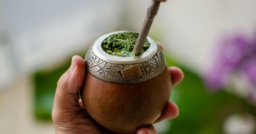

Effect of Yerba Mate (Ile... (2005)
by Elvira Gonzalez De Mejia


Tea flavonoids have antitopoisomerase activity and can inhibit cell proliferation. The objectives of this study were to determine the phenolic content of yerba mate tea products (MT) (Ilex paraguariensis) and evaluate their capacity to inhibit topoisomerase I (Topo I) and II (Topo II) activities and oral carcinoma cell proliferation. Total polyphenols of aqueous extracts of dried MT leaves were measured by the Folin-Ciocalteau assay, using chlorogenic (CH) and gallic (GA) acids as standards. Topoisomerase inhibition was determined by a clone-forming assay, which uses yeast (Saccharomyces cerevisiae) strains as a model. Controls included dimethyl sulfoxide (1.66%); camptothecin (50 ug/mL), a Topo I inhibitor; and amsacrine (100 ug/mL), a Topo II inhibitor. Cytotoxicity studies were conducted using a nontumorigenic human keratinocyte cell line HaCaT and two human squamous cancer cell lines (SCC-61 and OSCC-3). MT was found to be a rich source of phenolic compounds. Total polyphenol content of various commercially available traditional MT products ranged from 236 to 490 mg equiv of CH/g of dry leaves. Such levels were significantly different among products depending on their origin (P < 0.001).🏁
Global Leaderboard
| # | Player | Time | Duration | Accuracy | WPM | pp | |
|---|---|---|---|---|---|---|---|
| 1 | |||||||
| 2 | |||||||
| 3 | |||||||
| 4 | |||||||
| 5 | |||||||
| 6 | |||||||
| 7 | |||||||
| 8 | |||||||
| 9 | |||||||
| 10 |


Tea flavonoids have antitopoisomerase activity and can inhibit cell proliferation. The objectives of this study were to determine the phenolic content of yerba mate tea products (MT) (Ilex paraguariensis) and evaluate their capacity to inhibit topoisomerase I (Topo I) and II (Topo II) activities and oral carcinoma cell proliferation. Total polyphenols of aqueous extracts of dried MT leaves were measured by the Folin-Ciocalteau assay, using chlorogenic (CH) and gallic (GA) acids as standards. Topoisomerase inhibition was determined by a clone-forming assay, which uses yeast (Saccharomyces cerevisiae) strains as a model. Controls included dimethyl sulfoxide (1.66%); camptothecin (50 ug/mL), a Topo I inhibitor; and amsacrine (100 ug/mL), a Topo II inhibitor. Cytotoxicity studies were conducted using a nontumorigenic human keratinocyte cell line HaCaT and two human squamous cancer cell lines (SCC-61 and OSCC-3). MT was found to be a rich source of phenolic compounds. Total polyphenol content of various commercially available traditional MT products ranged from 236 to 490 mg equiv of CH/g of dry leaves. Such levels were significantly different among products depending on their origin (P < 0.001).🏁